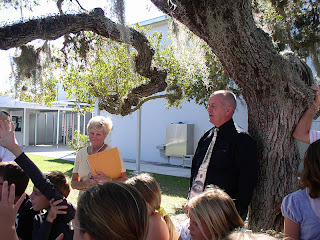On January 20, 2012, members of the Estero Island Garden Club assembled at Fort Myers Beach Elementary School on Fort Myers Beach to celebrate Arbor Day, 2012, with fourth grade students of that school. The Fourth Grade Foresters USA Project began in 2006. The goal of the project is to revitalize observation of Arbor Day in America’s schools and to send every fourth grader home with a tree of their own to plant and care for. So far, project sponsors, the Garden Club in this case, have distributed 279,000 trees to fourth graders in 3,269 schools across the country. The cost to the students is nothing; the sponsor pays $1.59 per tree plus shipping. The cost to our club was approximately $63.00 Each child receives an individually packaged seedling, 12 to 18 inches tall, that is recommended for growth in this area. The Sabal palm is the tree the children will receive today.
Garden Club members Lois, Madeline, Bobbi, Marge, Principal Wood,
Bonnie, Ken, Annie, Carol and Margaret
Ken and Bobbi
Bobbi is in charge of the project, and Ken will do a demo to show the children how to plant their trees. This is our club’s second year to take part in this project, and Ken, the husband of a garden club member, is going to do the demo this year. We never decided that a man must do the demo, but now we like it that way. And we have some very helpful husbands who are there when we need them.Members Marge, Lois, Carol, Annie, Bonnie and Margaret
in a shady area where the demo will take place
in a shady area where the demo will take place
Carol, fourth graders and their teacher await the demo
Longtime Garden Club members Marge and Lois
Bobbi and Principal Wood are ready for the program to get underway
Bobbi reads the poem, “Trees,” by Joyce Kilmer.
A very appropriate choice for this day.
A very appropriate choice for this day.
Trees
I think that I shall never see
A poem lovely as a tree.
A tree whose hungry mouth is prest
Against the sweet earth's flowing breast;
A tree that looks at God all day,
And lifts her leafy arms to pray;
A tree that may in summer wear
A nest of robins in her hair;
Upon whose bosom snow has lain;
Who intimately lives with rain.
Poems are made by fools like me,
But only God can make a tree.
By Joyce Kilmer
A poem lovely as a tree.
A tree whose hungry mouth is prest
Against the sweet earth's flowing breast;
A tree that looks at God all day,
And lifts her leafy arms to pray;
A tree that may in summer wear
A nest of robins in her hair;
Upon whose bosom snow has lain;
Who intimately lives with rain.
Poems are made by fools like me,
But only God can make a tree.
By Joyce Kilmer
Ken begins the demo to teach the children how to plant their trees.
The demo continues, and the children pay close attention to the planting technique.
A student examines a tree leaf
Ken trims off the brown leaves and long roots of the Sabal palm.
Ken adds soil to the planting.
A student examines a leaf sample.
A student examines a very small plant with roots.
The Sabal palm is planted in the pot, and now the students ask questions.
The students ask questions that indicate they have been paying attention to the demo.
They want to know about the soil, the depth of the planting and the best place to put the tree.
Marge and Ken Doty with potted palm
Garden Club members Becky, Bonnie, Carol, Margaret, Bobbi, Madeline and Annie
with dolphin in front of the elementary school
Fourth Graders have received a certificate stating
that they are “Fourth Grade Foresters,”
that they are “Fourth Grade Foresters,”
“Shades,“ the book describing native trees on Fort Myers Beach,
and the Sabal Palm sapling.
Estero Island Garden Club members and their 4th Grade Teacher are also in the photo.



















































